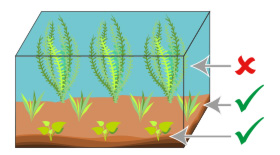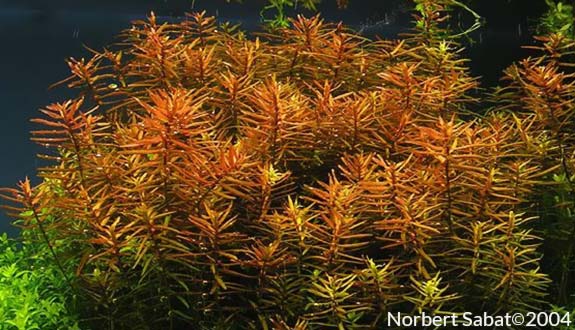

Alternative species (click on the thumbnail to see the card)
Names
Scientific name
Didiplis diandra
Peplis diandra
Common name
Peplis diandra
Origin

Origin: Central and North America
Ideal fertilization

CO2: 20-40mg/l
Nitrates (NO3): 10-50mg/l
Phosphates (PO4): 0.1-3mg/l
Potassium (K): 5-30mg/l
Iron (Fe): 0.01-0.5mg/l
Group

Lythraceae
Kind

Stem
Parameters

T°: 20 to 23°C or 68 to 73°F
pH: 6 to 7
Hardness: 5 to 10°dGH
Difficulty

Hard
Lighting

Average
Size

10 to 30cm (4 to 12")
Plantation

Foreground and Middle
Growth

Average
Presentation
Who is the Peplis diandra?
Presentation
Who is the Peplis diandra?
Its original aspect is due to its leaves resembling pine needles, giving it the appearance of a mini-fir tree.
In nature, this plant can be found in stagnant water (shallow ponds) with temperate temperatures. It can also be found on the banks of these ponds or faster moving streams. It is an amphibious species, which means that it can live on land as well as in water (fully emerged or submerged). However, note that plants that have grown out of the water will not become accustomed to total immersion.

It can be adapted to our tropical aquariums as long as it respects the rather limited temperature range (20 to 23°C or 68 to 73°F) that it can withstand.
Planting and maintenance
How to plant and maintain the Peplis diandra?
Planting and maintenance
How to plant and maintain the Peplis diandra?
It will be perfect to decorate your foreground or the background of your aquarium. Prefer a group planting of 15 to 20 plants, but each stem will be buried individually (space them a little). This is because the plant will need room to grow. In a completely submerged situation, it tends to grow in width and not in height. Therefore, it usually "crawls" to the bottom of the aquarium. In some cases, it can also grow tall, but this is less common.
It is essential to provide it with nutrients on a regular basis. CO2 diffusion is also recommended.
It is particularly vulnerable to filamentous algae. Beware of the brightness!
Farming
How to farm the Peplis diandra?
Farming
How to farm the Peplis diandra?
Purslane has many branches. To multiply your plants, simply cut off cuttings of about 10 cm and replant them a little further, always in groups.
Good To know
Find all additional information!
Good To know
Find all additional information!
You can do this in groups.
Its colour varies according to the lighting:
- intense: green leaves
- moderate: reddish leaves
Yours photos!
Comments
Sort by:
Please login to post comments

